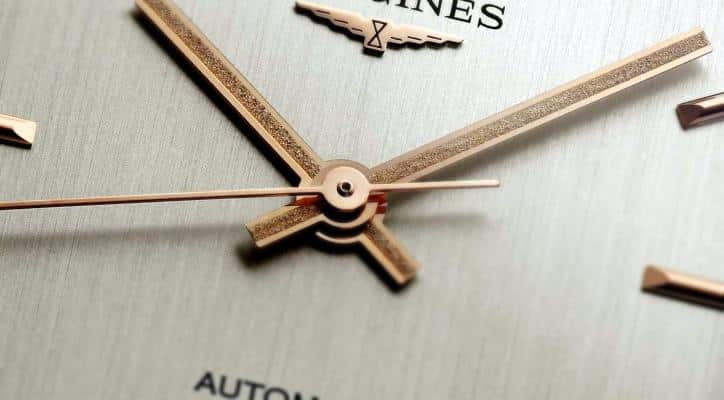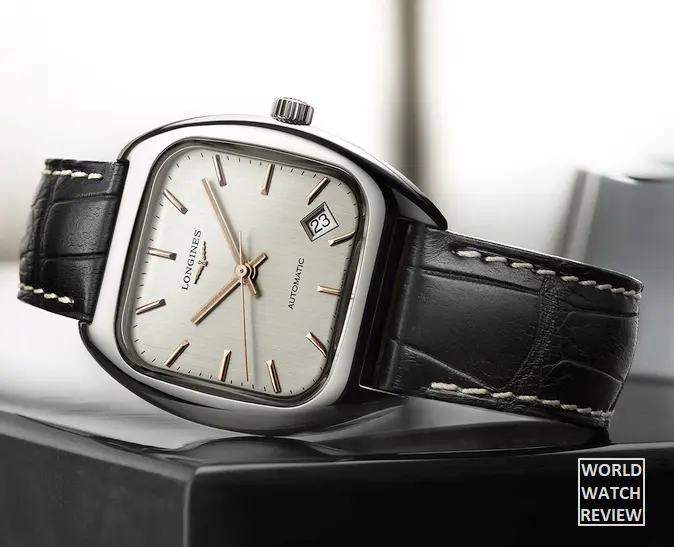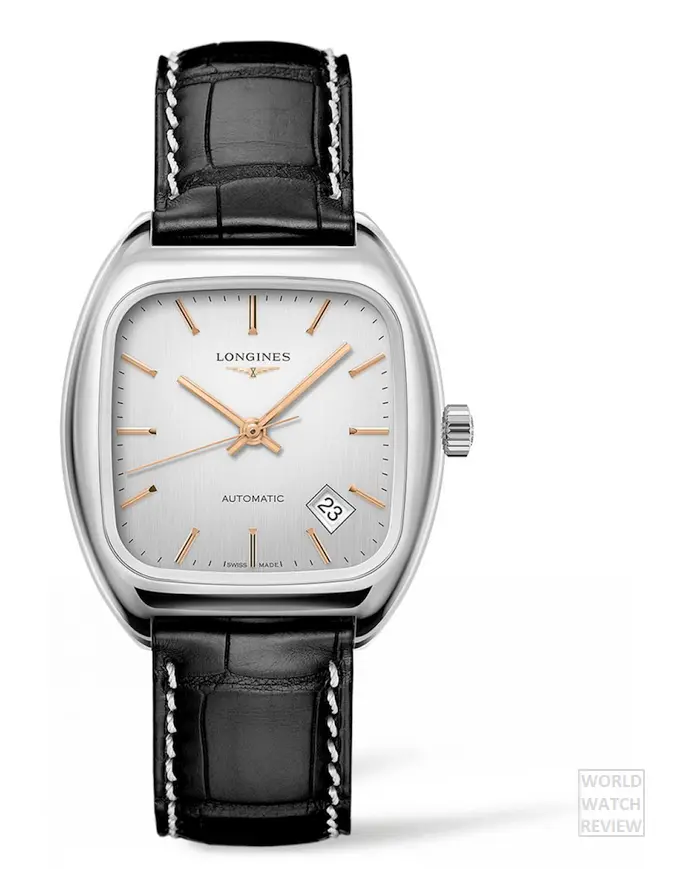
The 2016 Longines Heritage 1969 (ref. L2.310.4.72.0) is yet another bold attempt at reintroducing one of their many classic models to the modern audience. It is relatively inexpensive, although definitely far from affordable (if ‘affordability’ for you is something in the range where Certina and Tissot usually operate.) It is also powered by a fine-tuned version of one of the most robust self-winding calibers ever produced by ETA. All things considered, the Heritage 1969 may become an instant hit among those in need of a dressy timekeeper with a solid exterior and a bearable price tag.
Overall Impression
The main problem that has plagued Longines as a brand during the last couple of decades was that its ‘core’ product range was extremely generic. Yes, sporty watches were sporty and classic collections were, well, classic, but there was nothing particularly distinctive about them: they simply looked okay, there was some ‘premium’ feel about them and perhaps they were even selling well to those who didn’t want anything more than a watch from a reputable brand with the sacred “Swiss Made” inscription on its dial.
Or, putting it short, they were ‘entry-level’.
However, around five years ago something changed and Longines made a clear attempt to reinvent itself. Longines started by going back to their roots offering their loyal customers a series of “homages” that were based on their models from the 1940s, 1950s, and even 1960s. In other words, the brand turned its head to its legacy. This new Longines Heritage 1969, which, as you probably have already guessed, reproduces a model that was in production back in 1969 and featured an almost identical design, is, perhaps, one of the most interesting timekeepers issued by the Swiss-based brand during the last five years.
Yes, it is still an homage, but I hope that the company will take this (and other, like, say Heritage Military COSD, the 2014 Twenty-Four Hours Single Push-Piece Chronograph and, maybe, the Heritage 1973 Chronograph) model and use them as a base for their future collection discarding all those soulless Conquests and Dolce Vita lines for good (or at least putting them in some dark corner where no one will see them).

Case & Strap
I have already heard some complaints about how tiny the case is, but, as I never fail to repeat, I am extremely glad that most brands came to their senses and the trend of constant supersizing finally reversed.
Measuring 36 by 36 millimeters and featuring a set of short integrated lugs, the case is as elegant and, um, cultured as it is inconspicuous and discreet. All of its elements -starting with box-shaped sapphire crystal and going all the way to the tiny, yet easy-to-operate setting/winding crown- are deliberately low-key, yet extremely refined.
The crown, by the way, is slightly larger and longer than that on the original model, while the front sapphire crystal features multiple layers of anti-reflective coating on its inner side making the piece even more usable.
By the way, due to the recent spike of interest in all things vintage (or rather “vintage-styled” because almost nobody wants a real thing these days preferring an old-looking thing that is fully covered with a warranty, has good customer service, and enjoys an unlimited supply of aftermarket parts and accessories), the market is virtually flooded with respective products. If you, too, are into this sort of goods but find this particular Longines too expensive for you, there is a gorgeous, yet affordable Chr. Ward C5 Malvern Slimline Square hand-wound that was released earlier this year starting at an appealing MSRP of just £400 for a version on a leather strap. Although not as refined as this Heritage 1969, it still may be of interest to you, so make sure that you check it out.
The strap is different as well and is more in line with something that we sort of expect from a watch that retails for over $2000. While there is nothing fancy about the strap, the black band is crafted from nice alligator leather and features customary contrast stitching that echos the somewhat off-white color of the “silvered” dial.
The buckle is more or less a standard issue, but it suits the classic-shaped timekeeper style-wise although, when it comes to pure ergonomics, I would probably prefer something more comfortable like a deployment buckle. Well, you will probably need to replace the strap anyway after the first especially hot summer, so the choice of the buckle isn’t a real problem. It’s nothing more than a minor annoyance.

Dial
The choice of a smaller case to make an homage to the beautiful Sixties has also allowed making the dial a lot more well-proportionate than those on larger timekeepers that are powered by mass-produced mechanisms manufactured either by ETA or their younger competitors. As you can see, the face looks compact and organic. Everything is tightly packed, however, like an instrument panel of a well-designed car, the dial doesn’t look cluttered: it is efficient and economical.
Comparing photos of the new model with the original, I see that Longines tried to make the timekeepers look as close as possible. While the newer version looks more refined with almost half a century of technological progress behind it, they look almost identical.
I think I could’ve lived without the “AUTOMATIC” inscription in the lower part of the dial, but otherwise, I find it almost perfect.
There isn’t a single drop of Superluminova neither on the hands, nor on the hour markers here, but that, too, was preordained by the styling of the original and doesn’t annoy yours truly in the slightest. After all, this is a dress watch, not an aviator’s or diver’s companion, it is supposed to be readable in normal light and it passes the test with flying colors with the polished rose gold elements looking contrast enough over the vertically brushed surface of the dial for you to never strain your eyes even after a busy day in the office.
By the way, if you’d take a closer look at the hour and minute hands, you’d immediately notice that their inner parts are finely sandblasted to make them look even more refined and sort of unexpected in a relatively affordable product. A nice touch, that.
The way the small calendar window is positioned between four and five o’clock seems to bother many people, but, being a sort of faithful homage to the 1969 model, the Heritage 1969 had to look as close to the original as it was possible. I find this small trapezoid window really cute, but also feel the pain of those who would prefer the date aperture to either sit more symmetrically to the dial’s other elements (like, say, at six o’clock) or be gone altogether for an even cleaner look. But, again, this is what they used to call “homage”: not just your average “vintage-styled” watch with no legacy whatsoever.
Mechanism
The mechanism is, perhaps, of the least interest here, but in a good way.
As usual for the brand, it is a rather standard Longines caliber L888.2 that is also known to the general public as ETA A31.L01.
It is an unassuming self-winding ebauche that is based on the good old ETA 2892-A2 tractor caliber. As reliable and robust as it is, the newer movement still sports the same 21 functional jewels but has its frequency reduced by some ten percent to a bit slower 25,200 semi-oscillations per hour.
That, together with a new -also a tad longer- mainspring, resulted in an approximately fifty percent increase in power reserve, which is now guaranteed at a lot more appealing 64 hours. Basically, you put the watch in a drawer Friday night and get out Monday morning still ticking and still keeping a good time. Just make sure that the movement is fully wound before leaving it unmoving for such a prolonged time.
The base movement was also fine-tuned to higher specs and had some of its parts (including a more efficient winding rotor and the aforementioned longer mainspring) replaced with better ones. As a result, we got a movement that not only has a bigger power reserve but also has a running accuracy that, if my information is correct, is close to 3-4 seconds per day, which is nothing to sneeze at.
The mechanism has been here for about ten years if memory serves me well, and has a good reputation so I don’t expect you to encounter any hassle when it comes to servicing or repairing the caliber, which is a good thing when it comes to a sort of “white collar’s workhorse watch” that this Heritage 1969 is. Perhaps, the only thing that may disappoint you a little is a fairly basic level of finish of the mechanism, but that’s what one should expect when buying a watch in this price range from as well-advertised brand as Longines.
Pricing & Availability
It is reported that the Longines Heritage 1969 (ref. L2.310.4.72.0) is already available in the brand’s boutiques around the world sporting recommended retail price of $2050 in the United States and €1720 in Europe (although that, as usual, depends on local taxes.) As for online shops, they too offer the watch with discounts that range from 15 to 20 percent, but a great deal of them still mark it as “out of stock / on order”, so, if you plan to buy one online, you will probably have to do some proverbial legwork (however virtual it is) before finding a shop that has a good combination of price, availability and the return policy.
As I have already mentioned approximately one million times while writing this review, the price is competitive: I frankly doubt that you will be able to find a timepiece that offers this combination of exterior styling, quality of mechanism, impeccable congruity of all elements, and, well, impressive brand value at this sort of money.
See also: Longines Conquest Heritage 1954-2014 Edition
Photos: Longines
WWR verdict
Originality 4.5/5
Build quality: 5/5
Usability: 4.5/5
Legibility: 4.5/5
Value for money: 5/5
Longines Heritage 1969 Automatic L2.310.4.72.0 specification
Price: €1720 (MSRP)
Winding: Automatic
Movement: Longines caliber L888.2 (base ETA A31.L01), Swiss Made
Number of jewels: 21
Movement frequency: 25,200
Power reserve: 64 hours
Movement decoration: Branded oscillating weight
Functions: Hours, minutes, seconds, date
Case: Stainless steel
Shape: Cushion
Size: 36.00 mm x 36.00 mm
Dial: Silver, vertical brushing
Hour markers: Applied, gold-plated
Hands: Gold-plated, sand-blasted
Water resistance: 30 meters
Strap: Black alligator leather strap with a steel buckle
Crystal: Sapphire, anti-reflective coating inside
Back: Sapphire
